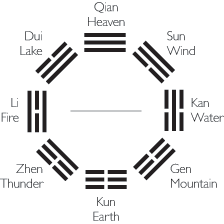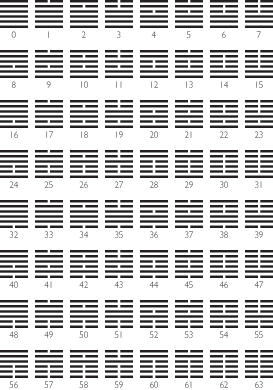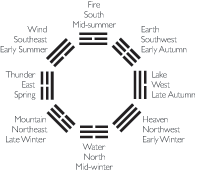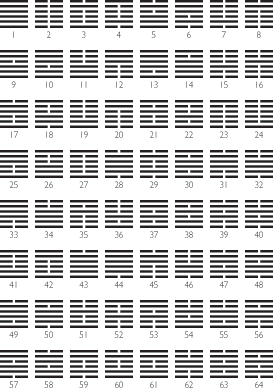Quick Start
This brief orientation introduces the primary concepts for a beginning understanding of the I Ching.
When the sun rises, the moon sets.
When the moon sets, the sun rises.
These lines describe life as cyclical movement, and represent one of the fundamental assertions of the I Ching.
The philosophical basis of the I Ching begins with the limitlessness that is our origin.
The first movement out of limitlessness is into yin and yang, the world of opposites: light and dark, male and female, hot and cold, hard and soft, and so on. They are symbolized as a straight line
 , yang ; and a split line
, yang ; and a split line  , yin . These opposites are not static; their balance is in constant flux.
, yin . These opposites are not static; their balance is in constant flux.
The four possible pairings (22) of these lines represent the initial interaction of yin and yang.

If we recombine the four pairs of lines with the primary yin and yang lines, we can express a further level of complexity (23). This set is called the Eight Trigrams. A trigram is a formation of three lines called a gua.

Each of the trigrams’ names symbolizes more than its literal meaning. This is clear because the trigram names are esoteric rather than ordinary words. For example, the heaven trigram is named qian instead of the more ordinary tian (sky). In the same way, the water trigram doesn’t use the common word for water, shui, but uses kan, a word that means a pit in the earth.
The Eight Trigrams are organized into an octagonal pattern called the bagua (ba means eight, gua means trigram). There are two versions. The first is called the Early Heaven sequence and is sometimes named after Fu Xi, the man credited with its creation.

The trigrams are arranged in polar opposites: heaven-earth, water-fire, wind-thunder, lake-mountain. Each pair’s relationship stands for fundamental principles:
heaven-earth: creation, nature, the cosmos
water-fire: forms of energy
wind-thunder: movement, development
lake-mountain: consolidation, social interaction.
The Eight Trigrams squared (82) generate the Sixty-Four Hexagrams. A hexagram is a formation of six lines. The Early Heaven hexagram arrangement follows a binary number sequence.
The top three lines of each row repeat the trigram order shown on page xiii: Heaven, Lake, Fire, Thunder, Wind, Water, Mountain, and Earth. The upper trigrams of each row are identical. If one reads down the lower trigrams in the first column, the same order is repeated.

Fu Xi’s sequence of hexagrams was revised by a feudal prince posthumously known as King Wen. In his formation, shown on the following page, the trigrams are arranged in a cyclical progression, read clockwise from the top. The trigrams were also assigned compass directions and seasonal associations:

King Wen arranged his hexagrams in pairs. He changed each odd-numbered hexagram into its opposite to generate the subsequent even-numbered one. Most are an overturning of the six lines. For example Hexagram 11 shows the Earth trigram above the Heaven trigram. Hexagram 12 inverts the lines:

Those few hexagrams which would be the same when turned upside down are reversed line for line (substituting a yin line for a yang line, and vice versa). Hexagrams 61 and 62 are an example.

Fu Xi’s Eight Trigrams are arranged as opposites, but his hexagrams are arranged in numerical order. King Wen’s Eight Trigrams are arranged cyclically, but his sequence of hexagrams is arranged as pairs of opposites. Overall, King Wen’s order, shown on the following page, begins with all yang (Hexagram 1) and yin (Hexagram 2) lines, and ends with perfect alternation of yin and yang lines (Hexagrams 63 and 64).

The sixty-four hexagrams have titles. We do not whether King Wen named them, or whether he was using preexisting names.
Each hexagram in the I Ching has three core texts:
The Statement: A short text attributed to King Wen, with such repeated phrases as “good fortune,” “no error,” or “misfortune,” combined with poetic images.
The Lines: A poetic comment on each line of each hexagram by King Wen’s fourth son, the Duke of Zhou.
The Image: Advice to a “noble one,” which could mean a ruler or a wise individual. This text is attributed to Confucius.
Most editions of the I Ching also include a group of appendixes called the Ten Wings, written by Confucius or later scholars.
While a complete view of the I Ching requires years of study, the following eight points summarize the philosophy of the I Ching.
1. Nature, society, and individuals all act through cyclical change.
2. Cycles of change are driven by polar opposites named yin and yang.
3. A cycle reaching its zenith descends toward its nadir. Likewise, the only path from nadir is ascent.
4. A cultivated person and an enlightened society act in accord with these cyclical movements, remaining aware of the numerous cycles they instigate each day. Ethical acts reinforce community and maintain beneficial cycles. Selfish acts increase isolation and generate destructive cycles.
5. A wise person engages in constant self-cultivation to become more sensitive to change.
6. Cultivated persons are not sad when misfortune occurs. They use the occasion to seek errors within themselves. By cultivating humility, they fend off further misfortune. They are modest and careful in times of great fortune. They are grateful and reverent. They will also consolidate their gains, search for nascent seeds of misfortune, and prepare for the future.
7. A person who can discern the cycles of life can learn to utilize them for his or her own ends. The I Ching advocates spirituality, humility, reverence, and service to others as the highest standards.
8. All endings are only transitions.
about the site
iching introduction











